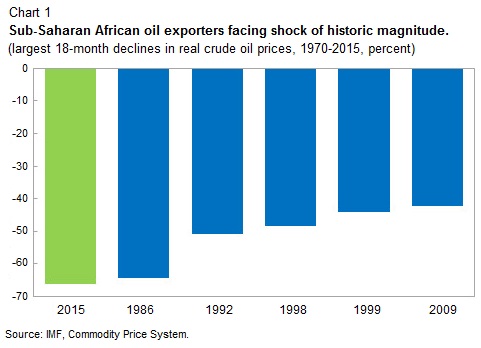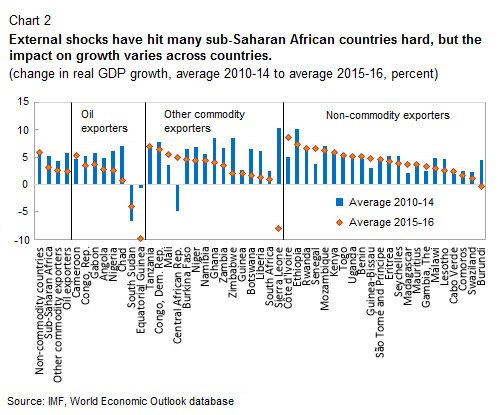News
Weakening growth in Sub-Saharan Africa calls for policy reset

After a prolonged period of strong economic growth, sub-Saharan Africa is set to experience a second difficult year as the region is hit by multiple shocks, the IMF said in its latest Regional Economic Outlook for Sub-Saharan Africa.
The steep decline in commodity prices and tighter financing conditions have put many large economies under severe strain, and the new report calls for a stronger policy response to counter the effect of these shocks and secure the region’s growth potential.
The report shows growth fell to 3½ percent in 2015, the lowest level in 15 years. Growth this year is expected to slow further to 3 percent, well below the 6 percent average over the last decade, and barely above population growth.
Hit by several shocks
The commodity price slump has hit many of the largest sub-Saharan African economies hard. While oil prices have recovered somewhat compared to the beginning of the year, they are still more than 60 percent below 2013 peak levels – a shock of unprecedented magnitude.

As a result, oil exporters such as Nigeria, Angola, and five of the six countries within the Central African Economic and Monetary Community continue to face particularly difficult economic conditions. The decline in commodity prices has also hurt non-energy commodity exporters, such as Ghana, South Africa, and Zambia.
Compounding this shock, external financing conditions for most of the region’s frontier markets have tightened substantially compared to the period until mid-2014 when they enjoyed wide access to global capital markets.
In addition, a severe drought in several southern and eastern African countries, including Ethiopia, Malawi, and Zimbabwe, is putting millions of people at risk of food insecurity.
Medium-term prospects still favorable
However, the impact of these shocks varies significantly across the region and many countries continue to register robust growth, including in per capita terms (see Chart 2).

In particular, most oil importers are faring much better with growth of 5 percent or higher in countries such as Côte d’Ivoire, Kenya, Senegal, and many low-income countries. These countries continue to benefit from infrastructure investment efforts and strong private consumption.
While the immediate outlook for many sub-Saharan African countries remains difficult, the region’s medium-term growth prospects are still favorable. The underlying domestic drivers of growth at play over the last decade generally continue to be in place. In particular, the region’s much improved business environment and favorable demographics should help bolster growth in the medium term.
Policy reset urgently needed to secure growth potential
To reap this strong potential, however, a substantial policy reset is critical in many cases, as the policy response to date has generally been insufficient.
In commodity exporting countries, where fiscal and foreign reserves are depleting rapidly and financing is constrained, the response to the shock needs to be prompt and robust to prevent a disorderly adjustment. Countries outside monetary unions should use exchange rate flexibility, as part of a wider macroeconomic policy package, to absorb the shock. As revenue from the extractive sector is likely durably reduced, many affected countries also critically need to contain fiscal deficits and build a sustainable tax base from the rest of the economy.
Given the substantially tighter external financing environment, market access countries with elevated fiscal and current account deficits will also need to recalibrate their fiscal policies to rebuild scarce buffers and mitigate vulnerabilities if external conditions worsen further.
The required measures may come at the cost of lower growth in the short-term. However, they will prevent what could otherwise be a significantly more costly disorderly adjustment. These policies would lay the ground work needed for the region to reap the substantial economic potential which still lies ahead.
In two background studies, the Regional Economic Outlook also examines the current commodity terms-of-trade shock and policy responses against past downswings, and the economic impact of progress made in financial development. The region has made strides in broadening access to financial services through the use of mobile technology, and the expansion of home-grown pan-African banks.
IMF calls for a policy reset to secure sub-Saharan Africa’s medium-term growth
After an extended period of strong economic growth, sub-Saharan Africa is set to experience a second difficult year as the region is hit by multiple shocks, the International Monetary Fund (IMF) said today.
According to its April 2016 Regional Economic Outlook for Sub-Saharan Africa, Time for a Policy Reset, growth in the region as a whole is projected to fall to 3 percent in 2016, the lowest level in some 15 years, albeit with considerable differences across the region.
While the outlook remains favorable, growth is well below the 6 percent that was customary over the last decade, and barely above population growth. “Africa needs a substantial policy reset to reap the region’s strong potential,” said Antoinette Sayeh, Director of the IMF’s African Department. “This is particularly urgent in commodity exporters and some market access countries, as the policy response to date has generally been insufficient.
The slowdown reflects the adverse impact of the commodity price slump in some of the larger economies and more recently the drought in eastern and southern Africa. The sharp decline in commodity prices, a shock of unprecedented magnitude, has put many of the largest sub-Saharan African economies under severe strain. As a result, oil exporters, such as Nigeria and Angola but also most countries of the Central African Economic and Monetary Union, continue to face particularly difficult economic conditions. Non-energy commodity exporters, such as Ghana, South Africa and Zambia, have also been hurt by the decline in commodity prices. Several southern and eastern African countries, including Ethiopia, Malawi, and Zimbabwe, are suffering from a severe drought that is putting millions of people at risk of food insecurity.
However, Ms. Sayeh stressed that the outlook remains favorable. “Many countries in the region continue to register robust growth. In particular, most oil importers are generally faring better with growth in excess of 5 percent in countries such as Côte d’Ivoire, Kenya, and Senegal, as well as in many low-income countries. In most of these countries, growth is being supported by ongoing infrastructure investment efforts and strong private consumption. The decline in oil prices has also benefitted many of these countries, though the drop in prices of other commodities that they export, and currency depreciations, have partly offset the gains. More broadly, medium-term growth prospects remain favorable, as the underlying drivers of growth at play domestically over the last decade generally continue to be in place. In particular, the much improved business environment and favorable demographics should play a supportive role in the coming decades.
“Faced with rapidly decreasing fiscal and foreign reserves and constrained financing, commodity exporters should respond to the shock promptly and robustly to prevent a disorderly adjustment. As revenue from the extractive sector is likely durably reduced, many affected countries critically need to contain fiscal deficits and build a sustainable tax base from the rest of the economy. For countries outside monetary unions, exchange rate flexibility, as part of a wider macroeconomic policy package, should also be part of the first line of defense.
“Given the substantially tighter external financing environment, market access countries in which fiscal and current account deficits have been elevated over the last few years will also need to recalibrate their fiscal policies. Such recalibration would help them to rebuild scarce buffers and mitigate vulnerabilities if external conditions worsen further.”




